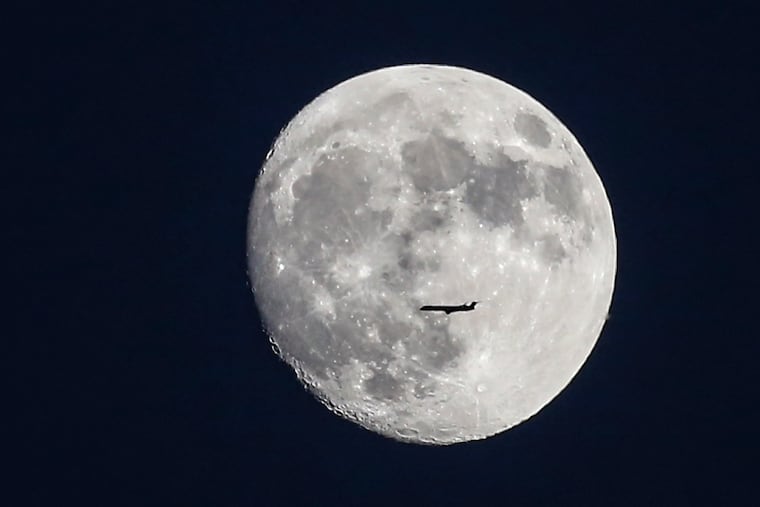A ‘supermoon’ is about to make its closest approach to Earth of 2022. Here’s what to know.
This week the moon will be a mere 222,089 miles from Earth, and will look close enough to touch when it rises.

The moon is about to make its closest approach to the Earth of 2022, and should you be facing southeast when it rises around 9 p.m. Wednesday with an unobstructed view, you might have the sensation that you’re about to have a close encounter with a spectacularly rising, outsize extraterrestrial body.
“The horizon effect is pretty neat,” says Karen Masters, a professor of astronomy and astrophysics at Haverford College. And it is a grand illusion that remains something of a scientific head-scratcher.
This won’t be your last chance to see this phenomenon, but this month’s rendition has an extra flash of drama in that on Wednesday it will be a particularly special “supermoon.” What exactly does that mean?
Probably less than the name implies, say Masters and other astronomers. The moon will indeed appear brighter than usual — significantly brighter than the weakest moon of the year — but the difference in visual size is likely to elude the observer.
Regardless, they say, the term has value: It is a boon to drawing attention to a mass of metal, dust, and rock that has profound effects on Earth’s weather and waters and the human imagination.
What is a ‘supermoon’?
Minted by an astrologer in 1979, the term has no technical definition. It is widely used in the astronomical community to describe those full moons that coincide with the moon’s nearest approaches to Earth.
The moon’s distance from Earth varies by 25,000 miles or so in roughly four-week cycles, with subtle distance differences cycle to cycle.
» READ MORE: Space tourism is taking off. Could the moon someday rival Avalon?
This time around, it will come within 223,000 miles of Earth, the closest approach of the year. That moment occurs at 5:06 a.m. Wednesday, and the moon will reach fullness about 9½ hours later.
What will we see?
The moon will appear about 14% larger than it would when it’s farthest from Earth, about 250,000 miles away. You likely won’t need moon-glasses, but it will beam its reflective sunlight 30% more brightly, Masters said.
Magical mystery
The visual difference in the moon’s size when it rises will be dramatically evident. It also will be an illusion tied to our neurological wiring. Various theories have been offered to explain it, but as NASA says, “There’s still not a satisfying scientific explanation for exactly why we see it.”
All we know for certain is that it keeps happening, and not just during supermoons.
“Any moon looks amazing and big and beautiful if you catch it just as it’s rising on the full moon night,” says Masters.
Why wait?
Although the moon won’t reach that 100% moment until 2:38 p.m. Wednesday, it will be ever-so-close Monday at 92% fullness, and Tuesday, 97%. Plus it will be brightening the skies earlier. It comes up at 9:02 p.m. Wednesday. It will still be close to full Thursday, but rising later.
Deception
We watch that mystical yellow and orange transformed into a white glow as the moon dominates the sky. But in real life, the entire moon is covered by a rubble pile of charcoal-gray, powdery dust that would gag a billion dust-busters.
Defenseless
Our atmosphere converts space debris to cosmic fireflies that we call meteor showers. Scientists believe the moon had a rough birth, formed from a chunk of Earth broken off during a collision with a Mars-size object maybe four billion years ago. Ever since, the defenseless moon has been pounded and pockmarked by asteroids and assorted space rocks. If the moon were boxing with the universe, the fight would have been stopped billions of year ago.
The dark side
The “dark side” of the moon is an Earth-centric concept. The moon gets sun all around. We just get to see only the same lighted side.
The weather
It’s not especially pleasant up there. Temperatures range from minus-414 to plus-253 degrees Fahrenheit. At least you don’t need an umbrella.
» READ MORE: Climate change as a factor in Jersey Shore flooding, and the moon doesn't help.
Speaking of the weather
Don’t be surprised to see nuisance coastal flood advisories this week. The moon’s effects on tides and flooding are well-known, but they are especially potent during a full moon occurring near perigee because not only is the moon that much closer to Earth, it is aligned directly with the sun, giving the tides an extra gravitational tug.
» READ MORE: The moon was a big player in the devastating 1962 Ash Wednesday storm
The moon is a sizable force, being nearly a third of the width of Earth. For comparison, NASA says to think of the Earth as a “nickel” and the moon as a “coffee bean.” (Efforts to locate a moon-shaped coffee been were unsuccessful.)
Researchers say the moon’s presence has helped stabilize Earth’s tilt on its axis toward the sun, thus protecting the rhythm of our seasons.
See it while it lasts
The moon is slowly moving away from Earth, getting about an inch farther away each year, or a mile every 63,360 years. So let’s enjoy it while we can.
Just call me ‘moon’
We’ve always called it just plain “moon” because it was named ages before Galileo discovered other moons in the solar system, in 1610.
Can we call you ‘supermoon’?
Sure, agree both the Franklin Institute’s Derrick Pitts and Karen Masters.
“Looking at the full moon in any month is nice to do,” said Masters. “If it takes a supermoon to get it into the minds of people to look up at the moon, I’m OK with it!”